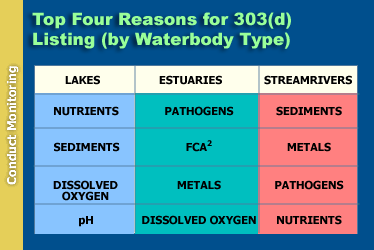

This graph shows that the most commonly cited causes of impairment vary from one major waterbody type to another. Of course, this does not mean that the key pollutants for a particular river, lake, or estuary would reflect the national picture shown here.
Because of the implementation of CWA regulatory programs controlling point sources of pollution over the last three decades, industrial facilities and municipal sewage treatment plants no longer are the major cause of impairment of most of the nation's surface waters. On the other hand, diffuse sources of precipitation-induced runoff (nonpoint sources under the CWA) are the sole cause of impairment of nearly half of the waters that states, territories, and authorized tribes list in their 303(d) reports. It is also likely that in many of the 50 percent of the impaired waters where both point and nonpoint sources are significant contributors, nonpoint sources contribute considerably more pollutant loads than do point sources.